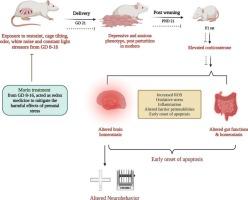Gestational morin administration attenuates prenatal stress-induced apoptotic and associated neurobehavioral alterations in F1 generation Wistar rats
IF 5.6
2区 医学
Q1 PHARMACOLOGY & PHARMACY
引用次数: 0
Abstract
Stress during prenatal period can affect the young ones, increasing the risk of aberrations in gut-brain of neonates during critical developmental periods and serves as a risk factor for postnatal pathologies. Compelling data from animal studies has shown that gestational stress-induced hyperactivation of the hypothalamic–pituitary–adrenal (HPA) axis, marked by excessive corticosterone (CORT) release, underlies profound and lasting developmental deficits in the offspring. It is well-established that stress during the gestational period disrupts gut and brain homeostasis in the F1 generation of Wistar rats. However, morin (3, 5, 7, 2′, 4′-pentahydroxyflavone), a plant flavonoid, exerts neuroprotective and antioxidant potential which could be beneficial in management of prenatal stress (PNS). Hence, this study was designed to evaluate the mitigatory potential of morin against the detrimental effects of prenatal stress, including the early onset of apoptosis in the gut and brain of the F1 offspring. Morin treatment to the stressed dams significantly improved HPA axis mediated oxidative stress and gut & brain barrier permeabilities. Furthermore, morin, due to its redox balancing and anti-inflammatory properties, prevented early onset of apoptosis, maintained the histoarchitecture and functions of gut & brain in F1 progeny. These findings provide a favourable research basis that morin administration during gestational period can significantly help in regulation of stress induced transgenerational gut-brain axis pathologies.

妊娠期给药可减轻F1代Wistar大鼠产前应激诱导的凋亡和相关的神经行为改变。
产前应激可影响新生儿,增加关键发育时期新生儿肠-脑异常的风险,是产后病理的危险因素。来自动物研究的令人信服的数据表明,妊娠应激引起的下丘脑-垂体-肾上腺(HPA)轴的过度激活,以过度的皮质酮(CORT)释放为标志,是后代深刻而持久的发育缺陷的基础。妊娠期的应激会破坏F1代Wistar大鼠肠道和大脑的稳态。然而,桑苷(3,5,7,2 ',4'-pentahydroxyflavone)是一种植物类黄酮,具有神经保护和抗氧化潜能,可能有益于产前应激(PNS)的管理。因此,本研究旨在评估桑辣素对产前应激不利影响的缓解潜力,包括F1后代肠道和大脑的早期凋亡。马桑素处理显著改善应激母鼠HPA轴介导的氧化应激和肠脑屏障通透性。此外,由于其氧化还原平衡和抗炎特性,桑辣素可以阻止F1后代早期发生的细胞凋亡,维持肠道和大脑的组织结构和功能。这些研究结果为妊娠期给药桑辣素对应激诱导的跨代肠-脑轴病变的调控提供了良好的研究基础。
本文章由计算机程序翻译,如有差异,请以英文原文为准。
求助全文
约1分钟内获得全文
求助全文
来源期刊

Biochemical pharmacology
医学-药学
CiteScore
10.30
自引率
1.70%
发文量
420
审稿时长
17 days
期刊介绍:
Biochemical Pharmacology publishes original research findings, Commentaries and review articles related to the elucidation of cellular and tissue function(s) at the biochemical and molecular levels, the modification of cellular phenotype(s) by genetic, transcriptional/translational or drug/compound-induced modifications, as well as the pharmacodynamics and pharmacokinetics of xenobiotics and drugs, the latter including both small molecules and biologics.
The journal''s target audience includes scientists engaged in the identification and study of the mechanisms of action of xenobiotics, biologics and drugs and in the drug discovery and development process.
All areas of cellular biology and cellular, tissue/organ and whole animal pharmacology fall within the scope of the journal. Drug classes covered include anti-infectives, anti-inflammatory agents, chemotherapeutics, cardiovascular, endocrinological, immunological, metabolic, neurological and psychiatric drugs, as well as research on drug metabolism and kinetics. While medicinal chemistry is a topic of complimentary interest, manuscripts in this area must contain sufficient biological data to characterize pharmacologically the compounds reported. Submissions describing work focused predominately on chemical synthesis and molecular modeling will not be considered for review.
While particular emphasis is placed on reporting the results of molecular and biochemical studies, research involving the use of tissue and animal models of human pathophysiology and toxicology is of interest to the extent that it helps define drug mechanisms of action, safety and efficacy.
 求助内容:
求助内容: 应助结果提醒方式:
应助结果提醒方式:


